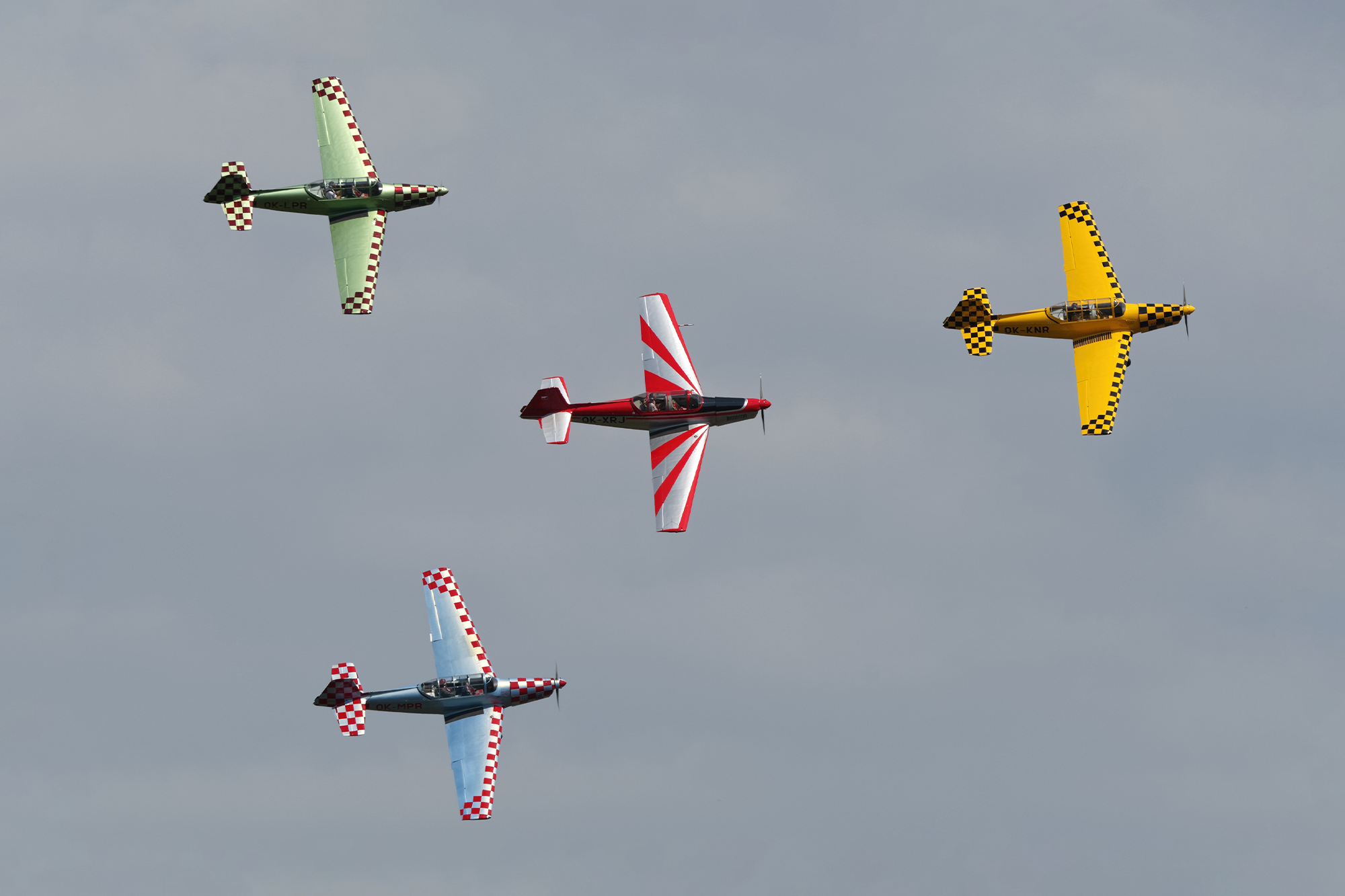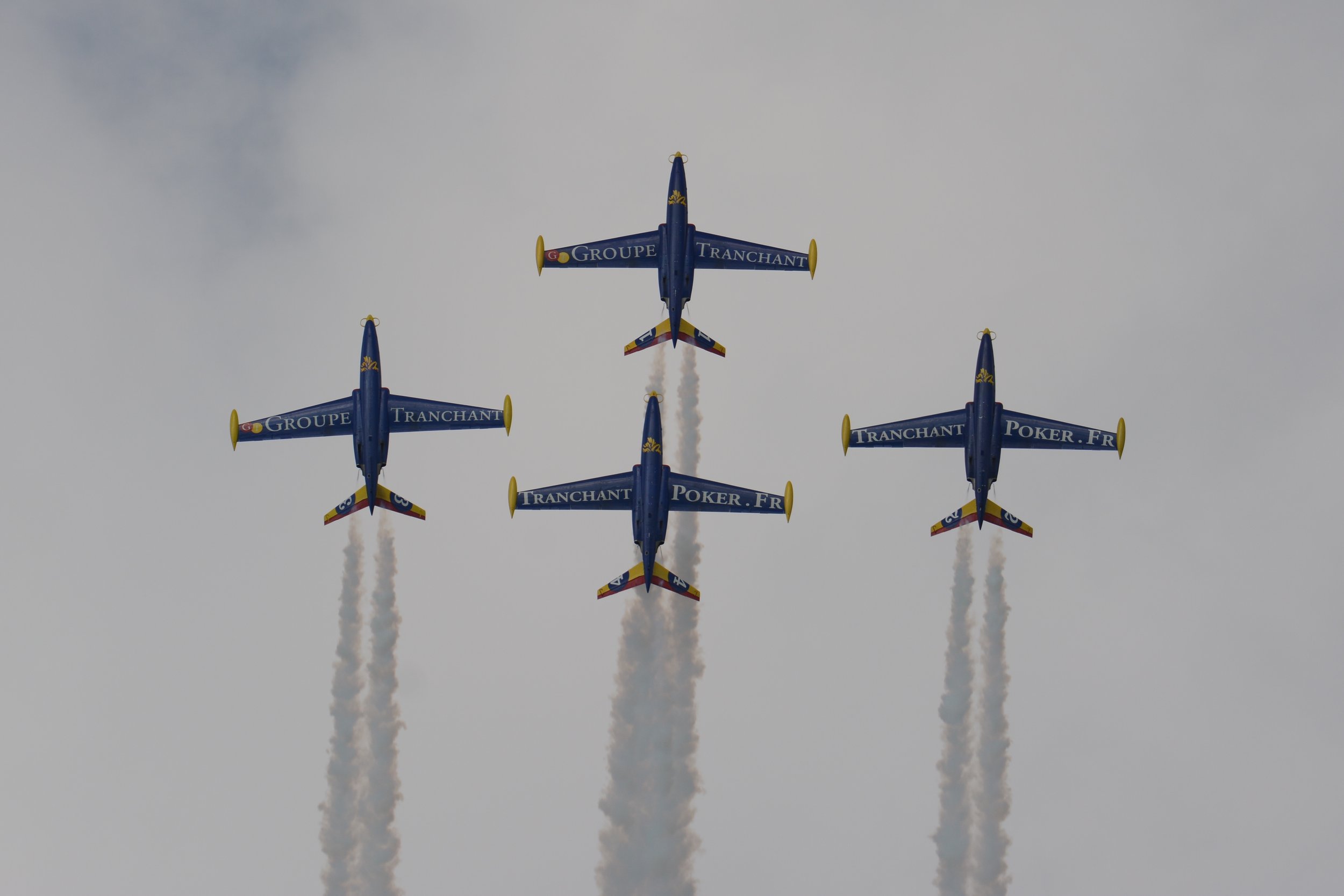Patrouille Tranchant
Country
France
Size
4/5 Aircraft
Base
Rennes Bretagne Airport
Patrouille Tranchant, a renowned French civilian aerobatic team, showcases their expertise in precision flying using the iconic Fouga Magister, a 1950s French two-seat jet trainer aircraft. Their fleet is outfitted with smoke generators that creatively paint the skies with vibrant colours, often depicting the national flags of the countries they perform in. Established by Jack Krine, Hugues Duval, and Benjamin Tranchant, the team operates from the base at Rennes Airport. Initially known for their four-aircraft formations, since 2019, they have impressed audiences with a stunning five-ship display. Noteworthy is their collaboration with the Patrouille de France, as they orchestrated a remarkable 13-ship flypast, paying homage to the Fouga Magister's legacy with the renowned French team. While predominantly showcasing their skills in France, Patrouille Tranchant has ventured beyond borders, capturing the hearts of aviation enthusiasts in Ireland at prestigious events such as the Bray Air Display and the Foynes Air Show.
| Back to Top |
Fouga CM.170 Magister
The Fouga CM.170 Magister is a 1950s French two-seat jet trainer aircraft, developed and manufactured by French aircraft manufacturer Fouga. Due to industrial mergers, the aircraft has been variously known as the Fouga CM.170 Magister, Potez (Fouga) CM.170 Magister, Sud Aviation (Fouga) CM.170 Magister and Aérospatiale (Fouga) CM.170 Magister, depending on where and when they were built.
In 1948, development commenced at Fouga on a new primary trainer aircraft design that harnessed newly developed jet propulsion technology. The initial design was evaluated by the French Air Force and, in response to its determination that the aircraft lacked sufficient power for its requirements, was enlarged and adopted a pair of Turbomeca Marboré turbojet engines. First flying on 23 July 1952, the first production order for the type was received on 13 January 1954. Export orders for the Magister were received, which included arrangements to produce the type under license in West Germany, Finland and Israel. In addition, the related CM.175 Zéphyr was a carrier-capable version developed and produced for the French Navy.
While primarily operated as a trainer aircraft, the Magister was also frequently used in combat as a close air support platform by various operators. In the latter capacity, it saw action during the Six-Day War, the Salvadoran Civil War, the Western Sahara War, and the Congo Crisis. In French service, the Magister was eventually replaced by the Dassault/Dornier Alpha Jet. After its retirement by the French Air Force, Magisters were purchased by several private-owner pilots in the US and have since been operated in the experimental category.
The Fouga CM.170 Magister was developed to perform both basic and intermediate training activities. It is a compact, tandem seat aircraft with performance akin to larger, more powerful aircraft. Comparatively, it was a higher performance aircraft than the rival British-built BAC Jet Provost and was considered by the Aviation magazine Flight International to be comparable to Fokker S.14 Machtrainer. It featured a distinctive butterfly tail configuration; a conventional tail was tried but found to be aerodynamically inferior at higher speeds. A keel fitted under the rear fuselage functions to reduce the negative dihedral effect of the butterfly tail during rudder applications.
The Magister was powered by a pair of Turbomeca Marbore turbojet engines, which provided 880 lb of thrust each; it was promoted as offering "twin-engine safety with single-engined flying characteristics". The two engines, which were placed close to the centre line, produced very little asymmetric thrust as a consequence; this was viewed as a valuable safety feature for a trainer aircraft. While viewed as an uncommon instance, in the event of a single-engine flameout the relighting procedure was relatively quick and easy to perform. The rate of acceleration and rate of climb was less than contemporary frontline jet fighters, such as the de Havilland Vampire and Gloster Meteor, but was in excess of many of the previous generation of piston-engined trainer aircraft. The engines shared a common fuel system, but had independent oil systems; for extended range, tip tanks were provided as standard equipment.
The design of the Magister paid close attention to the simplicity of operation; as such, a minimum number of procedures were necessary prior to take-off. Accessibility to both the engines and onboard equipment for servicing was above average; it was possible for both of the type's Marbore engines to be swapped out within 45 minutes. Provision was made for the installation of a pair of 7.5 mm guns upon the aircraft's nose, which included a 200-round ammunition box for each gun and the ability to collect both links and cases. Underwing hardpoints could be used to hold up to four rockets or a pair of 110 lb bombs. A landing light was installed in the tip of the nose while a retractable taxiing light was installed upon the Messier-built nosewheel. The landing gear was satisfactory for operations from austere grass airstrips.
The Magister was typically outfitted with avionics such as very high frequency (VHF) radio systems, Lear radio compass, and intercom; all cockpit electronics conformed to NATO accessibility standards. It was not provided with ejector seats in standard, but the fitting of various units was considered to be available upon request. The assorted levers, switches and dials that comprised the cockpit displays were typically easily observable, while ample room was provided for pilot comfort and space to accommodate a parachute. The standard blind panel is ahead of each pilot, and engine instruments are set to the left, while underneath these are the flap indicator, flap switch and emergency selectors, along with the two throttles and fuel cocks; the right forward bench carries the radio panel, and to the extreme right of that are the armament controls. The cockpit was pressurized as well as being provisioned with a fresh air system.
The pedals were adjustable and had fairly permissible limits, while the cockpit itself was relatively easy to access, the canopy opening upwards and rearwards while using only a single step due to its low height. In order to account for the poor forward visibility available to the rear seat, usually occupied by the instructor, the front screen was bulged and a binocular periscope was fitted, providing a relatively clear perspective over a relatively wide angle over the top of the front cockpit. The forward cockpit, normally used by the student, provided for excellent external visibility. According to Flight International, the Magister was able to perform various aerobatic manoeuvers "effortlessly", the flight controls were light and relatively well harmonized, and the stick has a firm sense of feel. It had a high level of lateral stability in flight, as well as being fairly directionally stable as well, allowing the aircraft to, when properly trimmed, be flown hands-off for indefinite periods.
| Back to Top |









| Back to Top |

































